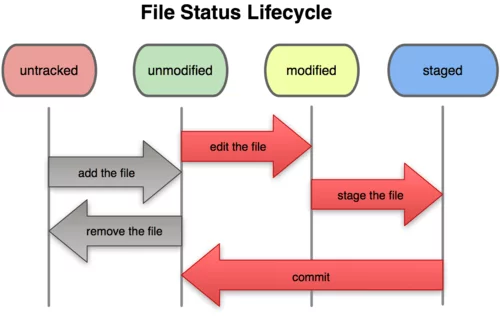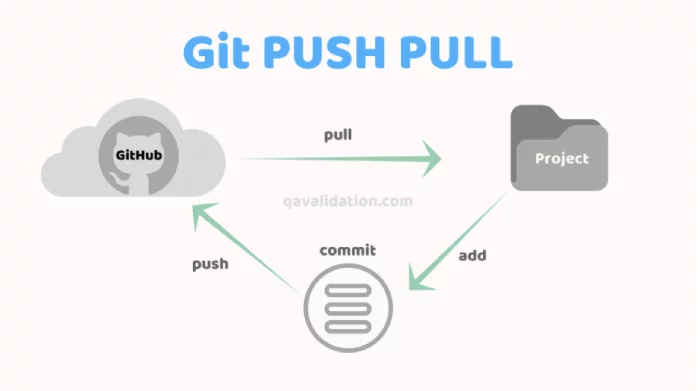This command works to get the files and compile them:
git clone a-valid-git-url
for example:
git clone git://cfdem.git.sourceforge.net/gitroot/cfdem/liggghts
However, git status (or any other git command) then gives the above fatal: Not a git repository (or any of the parent directories) error.
What am I doing wrong?
asked Aug 14, 2012 at 22:14
![]()
Kevin KostlanKevin Kostlan
3,2417 gold badges28 silver badges33 bronze badges
1
You have to actually cd into the directory first:
$ git clone git://cfdem.git.sourceforge.net/gitroot/cfdem/liggghts
Cloning into 'liggghts'...
remote: Counting objects: 3005, done.
remote: Compressing objects: 100% (2141/2141), done.
remote: Total 3005 (delta 1052), reused 2714 (delta 827)
Receiving objects: 100% (3005/3005), 23.80 MiB | 2.22 MiB/s, done.
Resolving deltas: 100% (1052/1052), done.
$ git status
fatal: Not a git repository (or any of the parent directories): .git
$ cd liggghts/
$ git status
# On branch master
nothing to commit (working directory clean)
answered Aug 14, 2012 at 22:19
Michael DurrantMichael Durrant
92.8k95 gold badges325 silver badges489 bronze badges
2
I just got this message and there is a very simple answer before trying the others. At the parent directory, type git init
This will initialize the directory for git. Then git add and git commit should work.
Syden
8,3555 gold badges26 silver badges45 bronze badges
answered Jan 10, 2017 at 21:40
2
In my case, was an environment variable GIT_DIR, which I added to access faster.
This also broke all my local repos in SourceTree 🙁
answered Oct 2, 2015 at 9:15
lucasvclucasvc
7671 gold badge11 silver badges35 bronze badges
2
Sometimes its because of ssh. So you can use this:
git clone https://cfdem.git.sourceforge.net/gitroot/cfdem/liggghts
instead of:
git clone git://cfdem.git.sourceforge.net/gitroot/cfdem/liggghts
answered Dec 19, 2016 at 3:44
![]()
Umit KayaUmit Kaya
5,7613 gold badges38 silver badges52 bronze badges
1
If Existing Project Solution is planned to move on TSF in VS Code:
open Terminal and run following commands:
-
Initialize git in that folder (root Directory)
git init -
Add Git
git add . -
Link your TSf/Git to that Project – {url} replace with your git address
git remote add origin {url} -
Commit those Changes:
git commit -m "initial commit" -
Push – I pushed code as version1 you can use any name for your branch
git push origin HEAD:Version1
answered Jun 17, 2020 at 8:46
in my case, i had the same problem while i try any git — commands (eg git status) using windows cmd. so what i do is after installing git for window https://windows.github.com/
in the environmental variables, add the class path of the git on the “PATH” varaiable. usually the git will installed on C:/user/"username"/appdata/local/git/bin add this on the PATH in the environmental variable
and one more thing on the cmd go to your git repository or cd to where your clone are on your window usually they will be stored on the documents under github
cd Document/Github/yourproject
after that you can have any git commands
EricSchaefer
25.1k21 gold badges67 silver badges103 bronze badges
answered Aug 11, 2014 at 17:41
git clone https://github.com/klevamane/projone.git
Cloning into 'projone'...
remote: Counting objects: 81, done.
remote: Compressing objects: 100% (66/66), done.
remote: Total 81 (delta 13), reused 78 (delta 13), pack-reused 0
Unpacking objects: 100% (81/81), done.
you have to “cd projone”
then you can check status.
One reason why this was difficult to notice at first, i because you created a folder with the same name already in your computer and that was where you cloned the project into, so you have to change directory again
![]()
answered Aug 30, 2017 at 6:31
This error got resolved when I tried initialising the git using git init . It worked
answered Jan 26, 2019 at 21:51
![]()
I had another problem. I was in a git directory, but got there through a symlink. I had to go into the directory directly (i.e. not through the symlink) then it worked fine.
answered Aug 14, 2014 at 16:56
![]()
Frank ConryFrank Conry
2,6433 gold badges29 silver badges35 bronze badges
In my case, the original repository was a bare one.
So, I had to type (in windows):
mkdir dest
cd dest
git init
git remote add origin avalidyetbarerepository
git pull origin master
To check if a repository is a bare one:
git rev-parse --is-bare-repository
answered Aug 9, 2017 at 10:34
MadlozozMadlozoz
3374 silver badges15 bronze badges
Simply, after you clone the repo you need to cd (change your current directory) to the new cloned folder
git clone https://User_Name@bitbucket.org/Repo_Name.git
cd Repo_Name
answered Jul 10, 2017 at 13:16
![]()
I suddenly got an error like in any directory I tried to run any git command from:
fatal: Not a git repository: /Users/me/Desktop/../../.git/modules/some-submodule
For me, turned out I had a hidden file .git on my Desktop with the content:
gitdir: ../../.git/modules/some-module
Removed that file and fixed.
answered Oct 4, 2018 at 19:39
![]()
i have the same problem from my office network.
i use this command but its not working for me
url,
so like this:
before
$ git clone https://gitlab.com/omsharma/Resume.git
After i Use this URL : $ git clone https://my_gitlab_user@gitlab.com/omsharma/Resume.git
try It.
answered Apr 19, 2019 at 5:49
![]()
In my case I was dealing with github workflow jobs and simply forgot to checkout the repo before my step. Adding pre requisite step actions/checkout@v2 resolved the issue.
answered Dec 12, 2022 at 6:31
![]()
A Git repository is a collection of files and information regarding past changes made in them. While working with Git, you may encounter errors that seem confusing, especially if you are a beginner and the terms used are not familiar to you. In this article, we will explore what causes, how to prevent, and how to solve the fatal: not a git repository error.
Table of Contents:
- What is the “fatal: not a git repository” error?
- What causes “fatal: not a git repository”?
- Solving “fatal: not a git repository”
- Preventing “fatal: not a git repository”
- How do Git repositories work?
a. Stage the files
b. Commit the changes
c. Push the code - What are some common Git errors?
a. Permission Denied
b. Failed to Push Some Refs
c. fatal: A branch named <branch-name> already exists.
d. Can’t switch between branches - What causes Git errors?
- Conclusion
What is the “fatal: not a git repository” error?
Most of the Git commands must be executed against a Git repository. For example, if you run git push -u origin master outside of a git repository, Git will simply not know what to push and where to push. The error above, fatal: not a git repository (or any of the parent directories): .git, states that you tried to execute a repository-specific command, outside of the Git repository. Fortunately, even if it is a very common problem, it is also very easy to solve.
![]()
What causes “fatal: not a git repository”?
The fatal: not a git repository error makes it clear that you’re not in a git repository, but the reason you’re not in such a repository may be one of two:
1. You tried to run the command but did not navigate to the project folder where the git repository is located.
2. You are in the project directory, but you didn’t initialize the Git repository for that project folder.
Solving “fatal: not a git repository”
Let’s refer back to the previous section where we discussed the two situations in which one gets a fatal: not a git repository error. To solve the first situation, check the folder in which you are currently trying to run the command again.
Is that the correct folder? If not then simply use the cd command to navigate to the correct path.
There is a simple trick that you can use to be sure that you always open a command prompt in the correct folder. Navigate to the project directory using the file explorer and then type in the search bar, cmd. This will open a command prompt to the current folder path.

For the second situation, you need to initialize the Git repository in your project folder. To do so, you need to navigate to the correct folder and then run the command git init, which will create a new empty Git repository or reinitialize an existing one.
Preventing “fatal: not a git repository”
When you run a Git command, the first step Git will take is to determine the repository you are in. To do this, it will go up in the file system path until it finds a folder called .git. Basically, the repository starts with the directory that has a .git folder as a direct child.
To prevent the fatal:not a git repository error, you need to make sure that you are in a Git repository before running any commands. One way you can do this is to check for the existence of the .git folder.
That period in front of the .git folder means that it’s a hidden folder. Therefore, it will not appear in the file explorer unless you have explicitly set it to show hidden folders.
On Windows, you can do this from the iew tab.

If you are on Linux or you use a console emulator that allows you to execute Linux commands, you can run the ls command with the flag -a to lists all files including hidden ones.
![]()
Another quick solution that you can use to check that you are inside a Git repository is to run the git status command. This command will show the current state of the repository if the current folder is part of a Git repository.
How do Git repositories work?
Git errors can be confusing, especially if you’re a beginner. This confusion mainly occurs because users are taught to create a connection between problem and solution, where someone encounters a problem and then looks for and uses a solution generally valid without trying to understand too much about the cause of the problem
This simple problem-solution connection is enough for most issues on Git: clone a repository, write some code, commit the changes and push the commits; or clone a repository, create a new branch, write some code, merge the branches and solve the conflicts. However, learning how Git works and its basic concepts will help you understand the technology you are working with and even do much more than those simple use cases described above.
Here’s some basic information to help you better understand how Git repositories work.
First and foremost, Git is a Distributed Version Control System (DVCS). With Git, we have a remote repository stored on a third-party server and a local repository stored in our local computer. Therefore, one can find the code in more than one place. Instead of having just one copy on a central server, we have a copy on each developer’s computer.

Source: Working with Git
Git, like any other software, must first be downloaded and installed in order to be used. You can even run the git --version command to see what your current version of Git is.
The first step to using a repository is to either clone one if you have access to it or to initialize one.
git clone <repo_path> and git init
These commands will create a new folder named .git, which will contain all the information about your repository that Git tracks: commits, branches, history, and so on.
The workflow of contributing to a Git repository is the following:
1. Stage the files
The first step is to add the files you want to add to a repository in the staging area. The purpose of this staging area is to keep track of all the files that are to be committed.
You can stage files using the git add <file_name> command or git add . to stage all the files.

Source: What are the differences between git file states
2. Commit the changes
The second step is to commit the changes. In this step, all the files that were added to the staged zone will be added to the local repository. The command for this is git commit -m "<your_message_here>". The message should be something relevant about the changes you have added.
3. Push the code
The last step is to push your changes from your local repository to the remote repository with the help of the git push command.
What are some common Git errors?
Fatal: not a git repository (or any of the parent directories): .git is just one of many other errors that can occur when working with Git. Here is a list of other common errors that may occur along with a brief explanation.
1. Permission denied
Permission denied when accessing 'url-path' as user 'username'
Git repositories can be of two types: public or private. In a public Git repository, everyone can view the code and clone it on their local machines. For the private ones, you need to be authenticated on the platform that the repository is hosted on in order to clone it onto your computer. At the same time, you need to have explicit rights to it.
The error stated above indicates that you possess an authenticated useraddname-password pair, but you do not maintain the files in the repository you are accessing. Thus, your assigned role in the repository must be increased to at least that of a maintainer or some similar position that the distribution platform provides, like maintainer, developer, admin, and so on.
2. Failed to Push Some Refs

Source: What are the differences between git file states
The purpose of Git is to collaborate and share work within a project while all the participants contribute to the same code base. One common scenario is when someone else pushes some code to the same branch you are working on, and you are trying to make your changes as well. The above error indicates that there is one more commit that was pushed to the same branch, but you don’t have that commit on your local machine.
To fix this, you can easily run a git pull origin <your-branch>, solve the conflicts if any, and then run git push origin <your-branch> to push your changes as well.
3. fatal: A branch named <branch-name> already exists
Most VCS (version control systems) have some form of support for branching mechanisms, including Git. Branches can be created directly in the remote repository, or they can be created locally and then pushed to the remote repository.
To create a new branch locally, you can run either:
git branch <new-branch or git branch <new-branch> <base-branch>
The first one, git branch <new-branch>, is used to create a new branch based on the currently checked out (HEAD) branch, meaning that if you are on a branch master and run git branch dev, it will create a new branch named dev from the branch master.
The second one is used when you want to create a new branch from a different branch, then the one that you are currently checked out. git branch qa master will create a new branch named ‘qa‘ from the master branch.
The branch names must be unique, therefore the error above, fatal: A branch named <branch-name> already exists., states that you already have a branch in your local repository with the same name.
4. Can’t switch between branches
Imagine this scenario: you have two branches, master and dev, both with committed files to the repository. On your local system, you do some changes in a file from the dev branch. At this point, if you want to move back to master and you run the command git checkout master, you will receive the following error:
error: Your local changes to the following files would be overwritten by checkout
This error means that you have some files that have been edited but not committed, and by checking out another branch, you’ll overwrite and lose these edits. The solution is to either commit these changes or if you don’t want to commit them yet, to stash them.
What causes Git errors?
Git errors are like any other CLI software errors. Most of the time, they represent a misuse of the command, wrong command names, missing parameters, wrong scope, etc.
There may also be cases where the error is not a user error but a software error. In those situations, either the application encountered a bug or the integrity of the application is corrupted. This can usually originate from missing data or the unintentional deletion of the required files.
In the former case, you can report the bug, and once it is fixed, the Git application can be updated. For the latter, the easiest solution is to remove the software and install it again.
Conclusion
Git is one of those applications you can use without ever thoroughly learning it because most of the time, the way you use it is straightforward as you limit yourself to the same commands over and over again. But if you never take the time to understand how it works and the philosophy behind it entirely, the confusion will never go away, and you can reach a stalemate if you have to do a few more complex operations. In this article, we covered the "fatal:not a git repository" error and everything to do with it, and then explored a few more Git errors.
Sometimes, a developer may encounter the fatal: not a git repository error when running any git command. This is a very common error but is luckily easily fixable.
This article will go through the causes and solutions for the fatal: not a git repository (or any of the parent directories): .git error.
Let’s get to it 😎.

Page content
- Why does the fatal: not a git repository error happen?
- How to fix the fatal: not a git repository error?
- Final thoughts
Why does the fatal: not a git repository error happen?
The fatal: not a git repository error happens because you are not inside a Git repository.
Here are a few reasons why this error happens:
- You are inside the wrong working directory.
- You didn’t initialize the Git repository.
- Your HEAD file is corrupted.
Luckily, each of those reasons is easily fixable.
How to fix the fatal: not a git repository error?
To fix this error, you need to go through the list of reasons, find the one that causes the error by using the elimination method and finally fix it.
Here is the process to follow:
1. Ensure you are inside the correct directory that contains the Git repository.
2. Verify that the Git repository has been initialized by checking if a .git folder exists.
To check if this folder exists, use the ls -la command.
If the .git folder does not exist in the correct directory, initialize the Git repository using the git init command.
bashgit init
3. Verify that the HEAD file is not corrupted.
bash> cat .git/HEAD
ref: refs/heads/main
If this command outputs something unexpected, find the branch you are working on and put it in your HEAD file.
One of those fixes should do the job and fix the error.
Final thoughts
As you can see, multiple reasons can cause this error.
Most of the time, however, it happens because you are not in the correct working directory.

Here are some other Git tutorials for you to enjoy:
- Reset to remote in Git
- Find the current tag with git describe

written by:
Hello! I am Tim Mouskhelichvili, a Freelance Developer & Consultant from Montreal, Canada.
I specialize in React, Node.js & TypeScript application development.
If you need help on a project, please reach out, and let’s work together.
Уровень сложности
Простой
Время на прочтение
4 мин
Количество просмотров 35K
Периодически от студентов приходят вопросы о работе системы контроля версий Git. Частая причина возникновения этих вопросов — непонимание разницы между репозиторием и обычной папкой.
Вот небольшая заметка на эту тему. Давайте разберемся, как работать с папками и репозиториями с точки зрения практики, то есть без строгих определений.
Пункт 1. Про папки и репозитории
Если папка — это то, к чему мы все привыкли как пользователи компьютеров, то репозиторий — это что-то новое, что нужно создать, инициализировать. Сам по себе репозиторий без наших указаний не появляется. Репозиторий в наших задачах — это папка, над которой были произведены некоторые действия, и Git в ней начинает выполнять свои задачи, например:
-
отслеживать изменения файлов;
-
хранить информацию о ветках.
Важно! Репозиторий не возникает сам по себе, его нужно создать.
Пункт 2. Как понять, в репозитории мы находимся или в папке
Самый простой способ это сделать — набрать в терминале команду «git status». Если в ответ вы увидите ошибку «fatal: not a git repository (or any of the parent directories): .git», значит, в терминале вы вызываете команду не из репозитория, а из обычной папки. Если вы увидели что-то другое, то вы находитесь в репозитории или внутри одной из папок, которая находится в нем.
Важно! Репозиторий отслеживает изменения во всех вложенных в него папках.
Если вы сделаете репозиторием корневую папку на диске C (не делайте этого!), то весь ваш диск станет репозиторием и Git будет пытаться отслеживать все изменения на этом диске. Создаем репозитории очень аккуратно.
Пункт 3. Как можно создать репозиторий
Чаще всего на начальных этапах рассматривают два способа создания репозитория:
-
Если мы находимся в папке (!) и хотим сделать из нее репозиторий, то вызываем команду «git init», и эта папка становится репозиторием.
-
Если мы хотим клонировать репозиторий из GitHub на свой ПК, то мы пользуемся командой «git clone». При этом обратите внимание: не нужно пользоваться командой «git init», команда clone не только скачивает файлы из интернета, но и инициализирует репозиторий в скачанной папке. На самом деле она делает сильно больше, но нам важно, что в скачанной папке у нас уже будет репозиторий и никак дополнительно инициализировать его не надо.
Пункт 4. Внимательно следим за тем, из какой папки вы вызываете команды
Терминал всегда показывает, в какой папке вы сейчас находитесь, но первое время студенты чаще смотрят на то, какая папка открыта в визуальном интерфейсе редактора (например, VSCode), а не на то, что написано в терминале. Обращайте, пожалуйста, внимание на название папки, которая указана в приглашении к вводу команд терминала. До тех пор, пока вы не привыкнете к работе с терминалом, внимательно следите за тем, что вы создаете репозитории только во вновь созданных для урока папках. Не нужно создавать репозитории из рабочего стола или других больших папок.
Пункт 5. Не нужно создавать репозитории внутри другого репозитория
Повторюсь: не нужно создавать репозиторий внутри репозитория. Прежде чем вызывать команды «git init» или «git clone», сначала убедитесь, что вы точно не внутри репозитория. Вызовите «git status» и убедитесь, что вы находитесь в папке, а не в репозитории. Если «git status» выдал ошибку «fatal: not a git repository (or any of the parent directories): .git», значит, вы в этой папке можете воспользоваться одним из способов создания репозитория, рассмотренным выше и на лекциях. Либо «git init», либо «git clone», но не обоими одновременно.
Важно! Иногда студенты сначала вызывают «git init» и потом «git clone». Но тем самым вы нарушаете правило не создавать репозиторий внутри репозитория. Обращайте на это внимание.
Пункт 6. Как репозиторий сделать обычной папкой
Когда вы создаете репозиторий, у вас в папке появляется новая скрытая папка с названием «.git». Это специальная папка, в которой хранится все, что необходимо для работы системы контроля версий. Если вы удалите эту папку, то потеряете всю историю, которую Git успел сохранить, но при этом превратите ваш репозиторий обратно в папку.
Итак, чтобы из репозитория снова сделать папку, достаточно всего лишь удалить скрытую папку «.git». При этом вы потеряете историю, которую собрал Git (все коммиты, ветки и т. п.), но файлы в самой папке останутся в том же виде, в котором они были в момент удаления папки «.git».
Пункт 7. Что делать, если все вокруг стало репозиторием
У студентов, которые неаккуратно вводят команду «git init», такое встречается. Поэтому давайте разберемся, что делать в такой ситуации. Надо проверить, успели ли вы уже совершить такую ошибку. Создайте новую пустую папку, например на рабочем столе, и в терминале вызовите «git status» в этой папке. Если вы увидите «fatal: not a git repository …», то радуемся. Все у вас в порядке.
Если же вы увидели что-то другое, значит, ваша вновь созданная папка является частью какого-то другого репозитория. Важно: мы только что создали новую папку и внутри нее никаких команд кроме «git status» не вызывали, то есть мы не создали сейчас новый репозиторий, но Git при этом не говорит нам, что это «not a git repository». Это может быть только в том случае, если вы эту новую папку создали уже внутри другого репозитория, то есть чуть раньше сделали репозиторием ваш рабочий стол или даже весь ваш диск C. Вылечить такую ситуацию можно следующим образом: нужно найти репозиторий, который вы создали по ошибке, и сделать его обратно папкой (см. предыдущий пункт — нужно удалить папку .git).
Если вы работаете на Windows, включите отображение скрытых файлов и папок, так как папка .git скрытая. Далее начинаем подниматься по иерархии папок вверх и искать в них папки «.git». Например, если вы создали папку по адресу «C:UsersUserPicturesControlCenterScan», то сначала проверяете папку Scan, потом проверяете папку ControlCenter, потом Pictures и так далее, пока не найдете скрытую папку .git. Когда нашли и удалили, проводим проверку из начала этого пункта заново.
Успехов в освоении Git и терминала!
An error that begins with “fatal” never sounds good. Do not worry; the cause of the fatal: not a git repository (or any of the parent directories): .git error is simple. This error is raised when you try to run a Git command outside of a Git repository.
In this guide, we talk about this error and why it is raised. We walk through two potential solutions so you can learn how to overcome a “not a git repository” error when working with Git. Without further ado, let’s begin!

Find Your Bootcamp Match
- Career Karma matches you with top tech bootcamps
- Access exclusive scholarships and prep courses
Select your interest
First name
Last name
Phone number
By continuing you agree to our Terms of Service and Privacy Policy, and you consent to receive offers and opportunities from Career Karma by telephone, text message, and email.
fatal: not a git repository (or any of the parent directories): .git
The cause of this error message is running a Git command outside of a directory in which a Git folder is initialized. For instance, if you try to run “git commit” in a non-Git folder, you see an error. Git cannot run unless you view a folder configured with Git.
This is because Git is configured in a specific directory. Every Git project has a secret folder called .git/. You can view this folder by running the following command:
.git/ contains all of the configuration files for a repository. Without this folder, Git does not know anything about a project. This folder contains information such as the Git remotes associated with a repository, Git environment variables, and your current HEAD.
Run git commit inside a folder that is not a Git repo:
This command returns:
fatal: not a git repository (or any of the parent directories): .git
Let’s solve this error.
Two Possible Causes
There are two possible causes for the “not a git repository” error.
Viewing the Wrong Directory
Check whether you view the correct directory. For instance, if you are in your home folder, you are not in a Git folder. If you are in a project folder, ensure it is the one where initialized a Git folder.
No Git Repository Has Been Initialized
If you are in a project folder and you see a “not a git repository” error, check whether a repository is initialized. You can do this by running ls -la and checking for a .git/ folder.
If no .git/ folder is present, you have not initialized a repository. This means there is no record of Git inside a particular project folder.
To solve this error, run git init in your project folder:
The git init command initializes a new Git repository in your current working directory.
Conclusion
The “not a git repository” error is common. The cause is running a Git command in the wrong folder or running a Git command before initializing a Git repository.
Now you’re ready to solve the “not a git repository” error like an expert developer!
